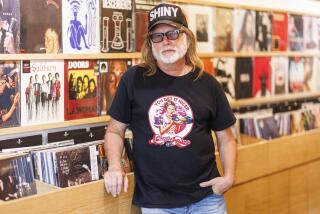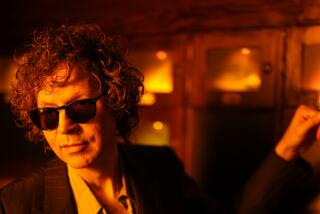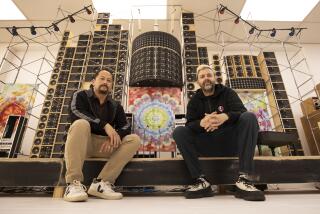A Real Spin Doctor : Turntable Retailer Bucks the CD Trend, Catering to Those Who Prefer Vinyl Over Digital
In an era when most music is memorialized on CD and laser disc, Brooks Berdan is keeping the record player alive.
*
His retail store, located in a nondescript industrial park in downtown Monrovia, is unknown to many of his neighbors. Yet it draws audiophiles from as far away as Turkey and Hong Kong who are willing to pay up to $15,000 for a turntable.
Berdan also consults with movie designers who want to capture the vintage vinyl look in their films and finds himself presiding over a mini-vinyl revival. Even though many Americans own those little silver discs, the LP market has stubbornly refused to die, and so have turntables.
After years of steep decline, audio experts say the market has bottomed out, leaving small niches where entrepreneurs like Berdan can flourish. His eponymous store, Brooks Berdan Ltd., stocks dozens of high-end new and used turntables that start at $500 and go up to $15,000.
Berdan, who caters mainly to the audiophile crowd, not the Circuit City shopper, keeps a low profile and gets business mainly by word of mouth or the small ads he places in specialty audio magazines.
âI donât need a clown standing on the corner with balloons waving people in. I really donât want walk-in traffic,â maintains 38-year-old Berdan, who said he has been fascinated by sound since he got his first stereo at age 7.
A tinkerer who has turned a hobby into a livelihood, Berdan lives in La Verne and commutes daily to Monrovia. Some of his customers come looking for new turntables. Others arrive lugging their old equipment, which they ask Berdan to calibrate or repair.
Berdan will even build new parts for old turntables whose manufacturers have gone out of business and left owners with equipment whose components cannot be replaced commercially when they break down.
âI donât know of anyone else doing what heâs doing,â said Ivan Berger, technical editor for Audio Magazine.
*
In April, 1994, Stereophile magazine christened Berdan âMr. Analog.â In analog technology, the electronic signal responds to physical changes such as a groove in a record; in digital technology, sounds or images are converted into groups of electronic bits and stored on a magnetic medium like a CD.
âBrooks is one of the true believers in analog. Heâs a keeper of the flame,â said Michael Fremer, senior music editor of the audiophile magazine The Absolute Sound and editor of The Tracking Angle, a music newsletter for audiophiles.
âHe supported analog during the darkest days when CDs seemed to be taking over and other dealers were getting out of it as quickly as they could because they saw the digital handwriting on the wall. He became a catch basket for all that analog, and now that records are making a comeback heâs come up smelling like a rose.â
Once a purchase is made, Berdan helps set up stereo systems in customersâ homes.
âPlacing speakers correctly is really important,â Berdan said. âA quarter-inch one way or another makes a lot of difference in the sound.â
Berdan is also called in to consult on movie projects requiring that pre-CD look. His most recent job was for the Robert Redford-Demi Moore movie âIndecent Proposal.â
The turntable maven loaned one of his more expensive models for use as a prop in the pivotal scene right before Redford and Moore dance off to bed. Berdan also coached Redford on how to cue up records on the turntable, whose complex, high-tech workings are light years away from the battered stereos that once adorned most college dorms.
Today, CD players claim the bulk of the market--4 million CD players sold last year vs. 500,000 turntables, according to industry statistics.
But todayâs customer can choose from among more than 100 turntable models made by 34 different manufacturers, which is up about 6% from what was available last year, according to Audio magazine.
Before opening his own store in 1987, Berdan spent years working at various stereo retail stores, honing his knowledge of both mass-market equipment and high-end models. In audiophile parlance, that means systems that start at about $2,000 and focus on the purest listening experience.
âThe whole idea for high-end listeners is not to listen to your stereo, but to recreate the original musical event, to make you think you are sitting in that symphony hall,â Berdan said.
To woo potential buyers as well as conduct his own research, Berdan has constructed a $25,000 listening room inside his retail store. Wooden âdiffusersâ line many of the walls to bounce back the sound. On another wall hangs a Persian carpet, which also helps the acoustics.
Even the plants arrayed throughout the room serve a function: Berdan says sound travels through the air best in a room that is maintained at 40% humidity, which is enhanced by green, well-watered plants.
He seats listeners in the middle of a strategically placed sofa to hear his analog sound system, so sophisticated that each musical instrument and percussive clap can be heard individually, like a crystal-clear bell.
âOnce they sit down in that room, I donât have to do much selling,â Berdan said.
For those for whom analog is but a dim memory, todayâs turntables range from $100 for a bottom-of-the-line Pioneer PL-203AZ to $30,000 for a Rockport Technologies Sirius Limited Edition model.
These days, the market for turntables is populated mainly by DJs, audiophiles, record collectors and young grunge-rock fans, who favor those anachronistic LPs.
Sub Pop Records in Seattle issues everything on vinyl. The group Pearl Jam sold 50,000 copies of its latest album on vinyl. Other bands now press a limited vinyl edition with their latest CD and many mom-and-pop labels never stopped putting out dance, rap and alternative rock on LP formats.
Jazz buffs are another market. Blue Note Records, which stopped releasing LPs in 1990, did an about-face in 1994 and reissued some of its classic jazz recordings, such as Ornette Coleman, Wayne Shorter and Bobby Hutchington on vinyl as well as CD to attract DJs, audiophiles and collectors.
Many audiophiles, including Berdan, claim records have a warmer sound, although CD buffs dispute that. But analog fans also talk wistfully of the rituals that accompany vinyl, including the pleasures of handling the thin platter, reading the liner notes and scrutinizing the cover art.
And they speak of the need to set up and calibrate analog equipment properly, install cartridges and clean records.
âUnfortunately, kids getting into (vinyl) have no idea where to turn. They go to Radio Shack, and the kid working at Radio Shack has no idea where to turn,â Fremer said. âNowâs the time to show kids how to do it right because the knowledge is being lost.â
That may also be true for more sophisticated music lovers with disposable income.
And thatâs where Berdan comes in.
âPeople are willing to spend $50,000 on a Persian rug, yet you walk into their house and theyâre listening to music on a tinny $500 stereo,â Berdan mused. âThey just donât know the quality that exists out there.â
More to Read
The biggest entertainment stories
Get our big stories about Hollywood, film, television, music, arts, culture and more right in your inbox as soon as they publish.
You may occasionally receive promotional content from the Los Angeles Times.










